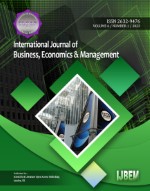Analysis of anomaly turn of the month effect on stock return in the Indonesian capital market before and during the COVID-19 pandemic
Keywords:
anomaly, COVID-19 pandemic, market efficiency, turn-of-the-month effectAbstract
This study aims to examine the presence of an anomaly in the turn-of-the-month effect in Indonesia before and during the COVID-19 pandemic. The population of this study are companies listed on the LQ45 index for the 2019-2021 period. Using the purposive sampling technique and obtained 36 samples of companies. This study will compare the average return and average abnormal return of each sample which has been grouped based on the turn of the month and the rest of the month both before and during COVID-19. This study used a different test, namely the paired sample t-test which was tested using the SPSS application. The analysis result provides evidence that there was an anomaly in the turn-of-the-month effect before COVID-19 and the effect disappeared when Indonesia experienced the COVID-19 pandemic. This study also found a difference in abnormal returns in the turn of the month before and during COVID-19 where the abnormal return value was higher during the COVID-19 pandemic.
Downloads
References
Agrawal, S., & Agrawal, J. (2015). Survey on anomaly detection using data mining techniques. Procedia Computer Science, 60, 708-713. https://doi.org/10.1016/j.procs.2015.08.220
Arendas, P., & Kotlebova, J. (2019). The turn of the month effect on CEE stock markets. International Journal of Financial Studies, 7(4), 57.
Ariel, R. A. (1987). A monthly effect in stock returns. Journal of financial economics, 18(1), 161-174. https://doi.org/10.1016/0304-405X(87)90066-3
Aziz, T., & Ansari, V. A. (2018). The turn of the month effect in Asia-Pacific markets: New evidence. Global Business Review, 19(1), 214-226.
Bagana, B. D. and Himmawan, D. N. A. (2018). Pertimbangan Investor dalam Berinvestasi Berdasarkan Day of The Week Effect dan Turn of Month Effect. Jurnal Bisnis dan Ekonomi, 25(2):186–193.
Brigham, E. F., & Daves, P. R. (2018). Intermediate financial management. Cengage Learning.
Chordia, T., Roll, R., & Subrahmanyam, A. (2008). Liquidity and market efficiency. Journal of financial Economics, 87(2), 249-268. https://doi.org/10.1016/j.jfineco.2007.03.005
Desyanti, V. A. (2017). Analisis Anomali Pasar Modal Di Indonesia (Studi Kasus Indeks LQ 45, Indeks Sektor Konsumsi Dan Indeks Sektor Keuangan Tahun 2014-2016). Jurnal Ilmiah Mahasiswa FEB, 5(2).
Elton, E. J., Gruber, M. J., Brown, S. J., & Goetzmann, W. N. (2009). Modern portfolio theory and investment analysis. John Wiley & Sons.
Fadly, S. R. 2021. Aktivitas Pasar Modal Indonesia Di Era Pandemi, Kementerian Keuangan Republik Indonesia.
Fama, E. F. 1970. Efficient Capital Markets: A Review of Theory and Empirical Work. The Journal of Finance, 25(2):383–417.
Firdaus, I.( 2021). 2 Maret Setahun Lalu, Jokowi Umumkan Pasien Pertama COVID-19, Kompas.
Harahap, R. M., Mustaruddin, M., & Rustam, R. (2021). The effect of efficiency, market power, debt, and risk on company performance and their impact on dividend policy on the manufacturing sector in the Indonesia stock exchange. International Journal of Business, Economics & Management, 4(4), 477-486. https://doi.org/10.21744/ijbem.v4n4.1804
Idris, M. (2017). Gajian PNS Tanggal berapa untuk Pusat dan Daerah?
Irtiza, M. S., Khan, S., Baig, N., Tirmizi, S. M. A., & Ahmad, I. (2021). The turn-of-the-month effect in Pakistani stock market. Future Business Journal, 7, 1-11.
Kayacetin, V., & Lekpek, S. (2016). Turn-of-the-month effect: New evidence from an emerging stock market. Finance Research Letters, 18, 142-157. https://doi.org/10.1016/j.frl.2016.04.012
Kayacetin, V., & Lekpek, S. (2016). Turn-of-the-month effect: New evidence from an emerging stock market. Finance Research Letters, 18, 142-157. https://doi.org/10.1016/j.frl.2016.04.012
Kim, K., Ryu, D., & Yu, J. (2021). Do sentiment trades explain investor overconfidence around analyst recommendation revisions?. Research in International Business and Finance, 56, 101376. https://doi.org/10.1016/j.ribaf.2020.101376
Kunkel, R. A., Compton, W. S., & Beyer, S. (2003). The turn-of-the-month effect still lives: the international evidence. International Review of Financial Analysis, 12(2), 207-221. https://doi.org/10.1016/S1057-5219(03)00007-3
Ningtyas, M. N. (2017). Pengujian Calendar Effect di Bursa Efek Indonesia tahun 2016. Jurnal Penelitian Teori dan Terapan Akuntansi (PETA), 2(2), 76-86.
Obalade, A. A., & Muzindutsi, P. F. (2020). Static or adaptive? the month-of-the-year and intra-month effects in African stock markets. International Journal of Monetary Economics and Finance, 13(3), 215-234.
Ogden, J. P. (1990). Turn?of?month evaluations of liquid profits and stock returns: A common explanation for the monthly and January effects. The Journal of Finance, 45(4), 1259-1272.
Oktaryani, G. S., Negara, I. K., Retnowati, W., & Kusmayadi, I. (2021). Fenomena Anomali Musiman Indeks Harga Saham Di Indonesia. Jurnal Magister Manajemen Unram Vol, 10(2).
Plastun, A., Sibande, X., Gupta, R., & Wohar, M. E. (2019). Rise and fall of calendar anomalies over a century. The North American Journal of Economics and Finance, 49, 181-205. https://doi.org/10.1016/j.najef.2019.04.011
Pompian, M. (2021). Behavioral Finance and Your Portofolio. John Wiley & Sons. Canada: Wiley.
Pratiwi, Y. R. (2022). Pemulihan perekonomian Indonesia setelah kontraksi akibat pandemi Covid-19. Diakses pada https://www. djkn. kemenkeu. go. id/kpknl-banjarmasin/baca-artikel/14769/Pemulihan-Perekonomian-Indonesia-Setelah-Kontraksi-Akibat-Pandemi-Covid-19. html.
Raffaele, P. O. & Rosella, P. S. (2020). The Cause of the Turn-of-month Effect in the Chinese Security Market: An Empirical Study of the Liquidity Hypothesis. Advanced Corporate Finance 1(1):1-60.
Schwert, G. W. (2003). Anomalies and market efficiency. Handbook of the Economics of Finance, 1, 939-974. https://doi.org/10.1016/S1574-0102(03)01024-0
Singh, G., Bhattacharjee, K., & Kumar, S. (2021). Turn-of-the-month effect in three major emerging countries. Managerial Finance, 47(4), 555-569.
Spees, K., & Lave, L. B. (2007). Demand response and electricity market efficiency. The Electricity Journal, 20(3), 69-85. https://doi.org/10.1016/j.tej.2007.01.006
Tadepalli, M. S., Jain, R. K., & Metri, A. B. A. (2022). An Enquiry into the Persistence of Turn-of-the-Month Effect on Stock Markets in India: Insights and Perspectives on a Seasonal Anomaly. Business Perspectives and Research, 10(1), 9-26.
Tadepalli, M. S., Jain, R. K., & Metri, B. (2021). An Inquiry into the Persistence of Holiday Effect on Stock Markets in India: Insights and Perspectives on a Seasonal Anomaly. FIIB Business Review, 23197145211016894.
Vidal, M., & Vidal-García, J. (2022). Turn of the Month Effect. Available at SSRN.
Published
How to Cite
Issue
Section
Copyright (c) 2023 International journal of business, economics & management

This work is licensed under a Creative Commons Attribution-NonCommercial-NoDerivatives 4.0 International License.
Articles published in the International Journal of Business, Economics & Management (IJBEM) are available under Creative Commons Attribution Non-Commercial No Derivatives Licence (CC BY-NC-ND 4.0). Authors retain copyright in their work and grant IJBEM right of first publication under CC BY-NC-ND 4.0. Users have the right to read, download, copy, distribute, print, search, or link to the full texts of articles in this journal, and to use them for any other lawful purpose.
Articles published in IJBEM can be copied, communicated and shared in their published form for non-commercial purposes provided full attribution is given to the author and the journal. Authors are able to enter into separate, additional contractual arrangements for the non-exclusive distribution of the journal's published version of the work (e.g., post it to an institutional repository or publish it in a book), with an acknowledgment of its initial publication in this journal.














